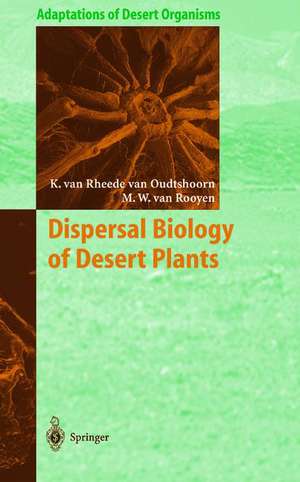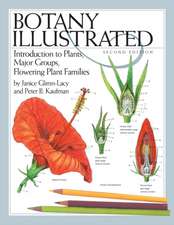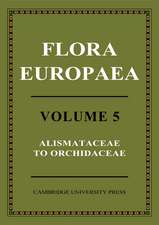Dispersal Biology of Desert Plants: Adaptations of Desert Organisms
Autor Karen van Rheede van Oudtshoorn, Margaretha W. van Rooyenen Limba Engleză Hardback – 4 dec 1998
| Toate formatele și edițiile | Preț | Express |
|---|---|---|
| Paperback (1) | 1378.27 lei 43-57 zile | |
| Springer Berlin, Heidelberg – dec 2010 | 1378.27 lei 43-57 zile | |
| Hardback (1) | 1384.44 lei 43-57 zile | |
| Springer Berlin, Heidelberg – 4 dec 1998 | 1384.44 lei 43-57 zile |
Din seria Adaptations of Desert Organisms
- 18%
 Preț: 954.14 lei
Preț: 954.14 lei - 18%
 Preț: 948.29 lei
Preț: 948.29 lei - 18%
 Preț: 945.92 lei
Preț: 945.92 lei - 18%
 Preț: 947.35 lei
Preț: 947.35 lei - 18%
 Preț: 946.10 lei
Preț: 946.10 lei - 18%
 Preț: 1212.68 lei
Preț: 1212.68 lei - 18%
 Preț: 953.82 lei
Preț: 953.82 lei - 15%
 Preț: 632.70 lei
Preț: 632.70 lei - 15%
 Preț: 635.31 lei
Preț: 635.31 lei - 15%
 Preț: 639.25 lei
Preț: 639.25 lei - 15%
 Preț: 639.73 lei
Preț: 639.73 lei -
 Preț: 382.57 lei
Preț: 382.57 lei - 15%
 Preț: 636.80 lei
Preț: 636.80 lei - 15%
 Preț: 640.24 lei
Preț: 640.24 lei - 15%
 Preț: 641.03 lei
Preț: 641.03 lei - 15%
 Preț: 636.45 lei
Preț: 636.45 lei - 15%
 Preț: 632.37 lei
Preț: 632.37 lei - 15%
 Preț: 637.28 lei
Preț: 637.28 lei -
 Preț: 378.92 lei
Preț: 378.92 lei - 15%
 Preț: 633.53 lei
Preț: 633.53 lei - 15%
 Preț: 693.71 lei
Preț: 693.71 lei - 15%
 Preț: 636.45 lei
Preț: 636.45 lei - 15%
 Preț: 641.53 lei
Preț: 641.53 lei -
 Preț: 388.34 lei
Preț: 388.34 lei -
 Preț: 395.63 lei
Preț: 395.63 lei
Preț: 1384.44 lei
Preț vechi: 1688.34 lei
-18% Nou
Puncte Express: 2077
Preț estimativ în valută:
264.92€ • 277.29$ • 220.49£
264.92€ • 277.29$ • 220.49£
Carte tipărită la comandă
Livrare economică 31 martie-14 aprilie
Preluare comenzi: 021 569.72.76
Specificații
ISBN-13: 9783540648864
ISBN-10: 3540648860
Pagini: 260
Ilustrații: XII, 242 p.
Dimensiuni: 155 x 235 x 20 mm
Greutate: 0.54 kg
Ediția:1999
Editura: Springer Berlin, Heidelberg
Colecția Springer
Seria Adaptations of Desert Organisms
Locul publicării:Berlin, Heidelberg, Germany
ISBN-10: 3540648860
Pagini: 260
Ilustrații: XII, 242 p.
Dimensiuni: 155 x 235 x 20 mm
Greutate: 0.54 kg
Ediția:1999
Editura: Springer Berlin, Heidelberg
Colecția Springer
Seria Adaptations of Desert Organisms
Locul publicării:Berlin, Heidelberg, Germany
Public țintă
ResearchCuprins
1 Background.- 2 Zoochory.- 3 Anemochory.- 4 Hydrochory.- 5 Autochory.- 6 Restriction of Dispersal Due to Reduction of Dispersal Structures.- 7 Restriction of Dispersal Due to Anchorage Mechanisms.- 8 Restriction of Dispersal in Time.- 9 Dispersal Spectra.- 10 Seed Dispersal and Population Dynamics.- References.- Index of Plant Names.- Index of Animal Names.
Recenzii
From the reviews:
"One of the fundamental aspects in adaptation of desert organisms is the dispersal biology of the diaspores, which again is the basis for the establishment and habitat occupation by plants, the components of plant communities. With "Dispersal Biology of Desert Plants" in the series "Adaptations of Desert Organisms" there is now a comprehensive treatise on this subject available. .... This book breathes the spirit of great desert botanists, e.g. Murbeck and Zohary. It is of basic importance in dispersal biology of desert plants and certainly will be a basis for future works in diaspore dispersal." (Plant Systematics and Evolution)
"One of the fundamental aspects in adaptation of desert organisms is the dispersal biology of the diaspores, which again is the basis for the establishment and habitat occupation by plants, the components of plant communities. With "Dispersal Biology of Desert Plants" in the series "Adaptations of Desert Organisms" there is now a comprehensive treatise on this subject available. .... This book breathes the spirit of great desert botanists, e.g. Murbeck and Zohary. It is of basic importance in dispersal biology of desert plants and certainly will be a basis for future works in diaspore dispersal." (Plant Systematics and Evolution)
Textul de pe ultima copertă
Dispersal processes, i.e. those processes occurring between the time of seed maturation and germination, have important effects on plant distribution and abundance.
Although adaptations to long range dispersal (telechory) are by no means rare in desert plants, many desert plant species do not possess any features to promote dispersal (atelechory), while others have structures that hamper dispersal (antitelechory). The high frequency with which atelechorous and antitelechorous mechanisms are present in plants inhabiting arid areas indicates the importance of these adaptations. Among the benefits derived from these adaptations are the spreading of germination over time, the provision of suitable conditions for germination and subsequent seedling establishment and the maintenance of a reservoir of available seeds.
This book describes the ways and means - anatomical, morphological and ecological - by which dispersal in desert plants has evolved to ensure the survival of these species in their harsh and unpredictable environment.
Although adaptations to long range dispersal (telechory) are by no means rare in desert plants, many desert plant species do not possess any features to promote dispersal (atelechory), while others have structures that hamper dispersal (antitelechory). The high frequency with which atelechorous and antitelechorous mechanisms are present in plants inhabiting arid areas indicates the importance of these adaptations. Among the benefits derived from these adaptations are the spreading of germination over time, the provision of suitable conditions for germination and subsequent seedling establishment and the maintenance of a reservoir of available seeds.
This book describes the ways and means - anatomical, morphological and ecological - by which dispersal in desert plants has evolved to ensure the survival of these species in their harsh and unpredictable environment.
Caracteristici
The first book to illustrate the various dispersal types that enable desert plants to survive Contains a glossary of terms and a species index













